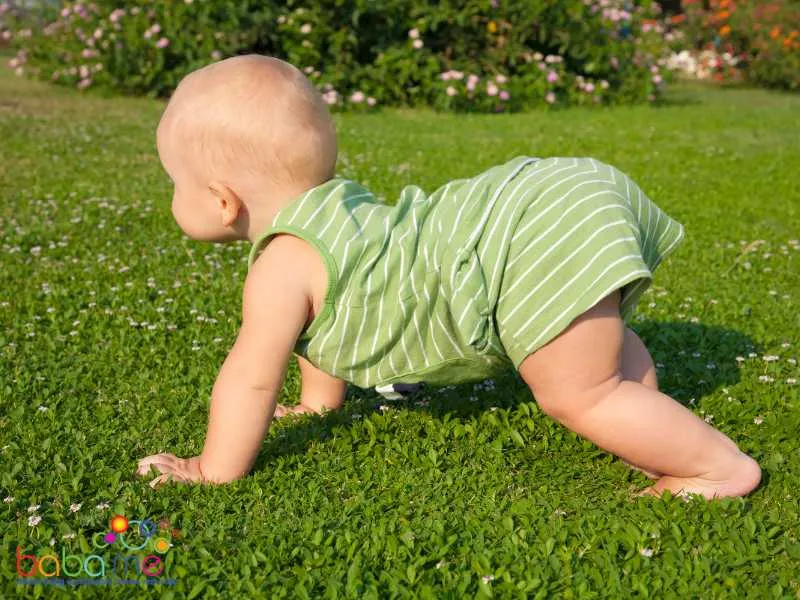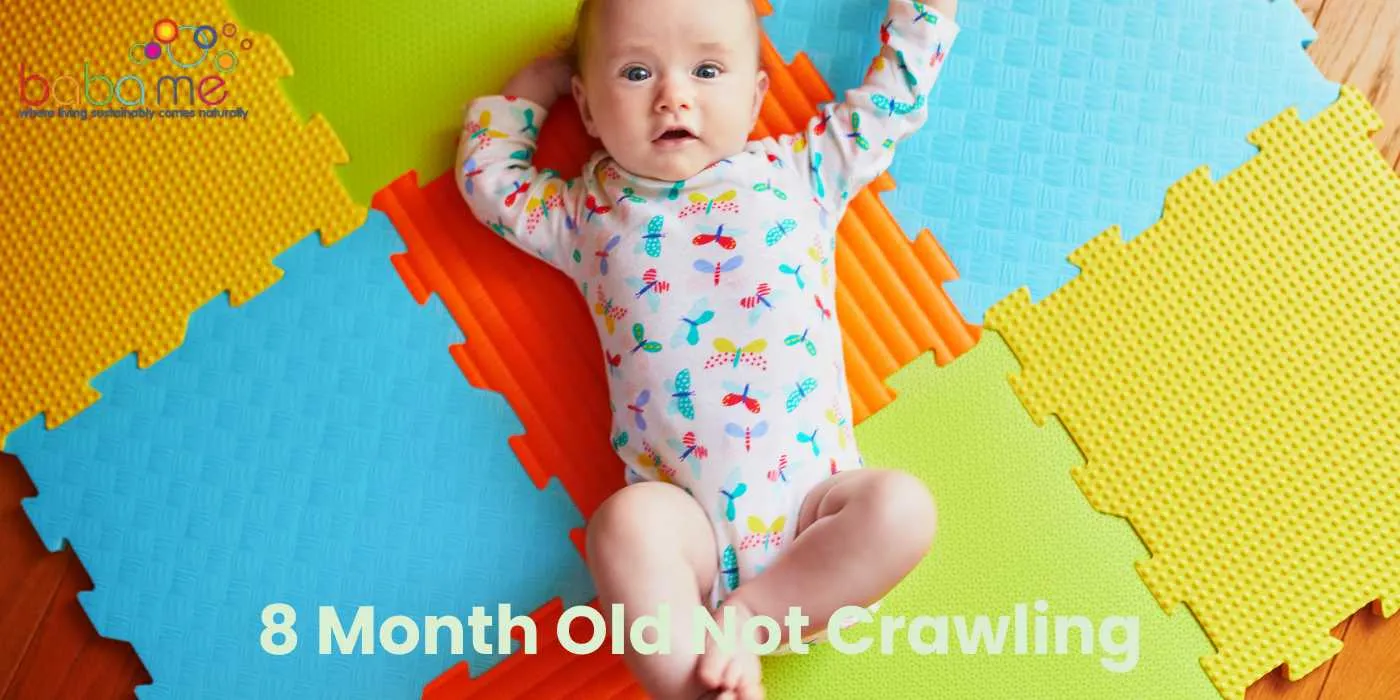As a parent, it’s only natural to anticipate your baby’s major milestones, with crawling being one of them. But what if your 8-month-old is not crawling?
While it’s easy to feel concerned, it’s crucial to remember that each child develops at their own pace. In this article, we’ll explore why some babies may not crawl at this age and how you can support their physical development.
About half of babies begin crawling by 8 months, while others may start before 6 months or not crawl until after 11 months. If your baby is not crawling yet, it does not necessarily mean that there is a problem. If your 8-month-old is not crawling yet, there’s no need to worry. Babies develop at different rates and crawling is not a mandatory milestone. Some babies skip crawling altogether and move directly to pulling up, cruising, or even walking.
Possible Reasons for Not Crawling
There could be several reasons why a baby may not start crawling at the expected age:
Different Developmental Pace
All babies develop at their own pace, and some may just take longer to start crawling than others.
Preference for Other Methods of Mobility
Some babies prefer other ways of getting around, such as rolling, scooting on their bottoms, or even walking.
Physical Development
Babies need certain physical skills to crawl, including muscle strength and coordination. If these are developing more slowly, it may delay crawling.
Limited Tummy Time
Tummy time helps babies build the strength necessary for crawling. Babies who have less tummy time may start crawling later.
Birth Order
Firstborn babies may crawl later because they have less motivation to keep up with older siblings.
Health Issues
Certain health conditions, such as low muscle tone, could delay crawling.
Environment
If babies are often confined in playpens, baby seats, or cribs, they may have fewer opportunities to practice crawling.
Muscle Weakness or Delayed Development
One possible reason why your baby is not crawling yet is that they may have muscle weakness or delayed development. This could be due to a variety of factors, such as premature birth, low birth weight, or genetic conditions

Lack of Motivation or Interest
Another possible reason why your baby is not crawling yet is that they may simply lack motivation or interest. Babies develop at their own pace, and some may take longer to show an interest in crawling. You can encourage your baby to crawl by providing plenty of tummy time, placing toys just out of reach, and creating a safe and stimulating environment.
Medical Conditions
There are some medical conditions that can delay crawling, such as cerebral palsy or Down syndrome.
When to Seek Professional Help
If your baby is not crawling by 10 months of age, it’s important to consult with your pediatrician to rule out any underlying medical conditions or developmental delays. Your pediatrician may refer you to a specialist, such as an occupational therapist, physical therapist, or developmental pediatrician, who can evaluate your baby’s development and provide appropriate support and treatment.
How Does Crawling Develop?
Crawling is a complex skill that develops gradually as a baby gains strength and coordination. Here’s a rough timeline of how crawling typically develops:
1. Tummy Time (Birth-3 months): From birth, babies benefit from tummy time, which helps to strengthen their neck and shoulder muscles.
2. Rolling Over (3-6 months): Babies learn to roll over, which exercises their muscles and develops the coordination necessary for crawling.
3. Sitting Up (6-7 months): Babies start sitting up unaided, gaining the strength and balance needed to move on their own. The sitting position is the vital first step. Babies discover their feet and try and press on them whenever you hold them up.
4. Rocking Back and Forth (6-9 months): Babies tend to start to rock back and forth on their hands and knees. This rocking motion helps to strengthen the muscles needed for crawling.
5. Crawling (6-10 months): Baby crawls after they’ve learned to sit up and balance on their hands and knees. Some babies start with a “commando” crawl, pulling themselves forward on their bellies.
6. Perfecting the Baby Crawl (9-12 months): Babies perfect their crawling skills, moving quickly and efficiently around their environment.

Ways to Encourage Crawling
Encouraging your baby to crawl involves fostering their physical development and creating a safe and engaging environment for them to explore. Here are some ways to do this:
1. Tummy Time: Tummy time is crucial in developing the neck, back, and shoulder muscles needed for crawling. Start with a few minutes a day and gradually increase the time as your baby becomes more comfortable.
2. Create a Safe Space: Make sure the area where your baby is practicing crawling is safe. Use baby gates to block off unsafe areas and remove any small objects that could be a choking hazard.
3. Encourage Exploration: Place toys or other objects of interest just out of your baby’s reach to motivate them to move towards the item.
4. Be a Role Model: Get down on your hands and knees and show your baby how it’s done. You can make a game out of it to make it more engaging.
5. Use a Mirror: Babies love looking at their reflection. Place a mirror in front of your baby during tummy time to pique their interest and encourage movement.
6. Use a Crawling Tunnel: Crawling tunnels or tents can be exciting for babies and encourage them to move forward.
7. Cheer Them On: Always encourage and cheer on your baby’s efforts. This will boost their confidence and motivate them to keep trying.

Tummy Time
One of the best ways to encourage crawling is to give your baby plenty of tummy time. This helps them develop neck muscles and initiate their crawling reflexes. Start tummy time from birth and gradually increase the duration as your baby grows. You can place toys and objects around them to encourage them to reach out and crawl towards them.
Crawling Practice
Encourage your baby to practice crawling by placing them on their hands and knees and gently rocking them back and forth. You can also place a toy in front of them and encourage them to crawl towards it. Make sure to always supervise your baby during crawling practice and provide a soft surface for them to crawl on.
Playing with Toys
Playing with toys can also encourage crawling. Place toys just out of your baby’s reach so that they have to crawl towards them. You can also place toys on a slightly elevated surface to encourage your baby to crawl up and reach for them.
Assisted Walking
Assisted walking can also help encourage crawling. Hold your baby’s hands and gently guide them to walk towards a toy or object. This can help build strength in their legs and encourage them to crawl towards objects on their own.

Quick Guide to Crawling Styles
Here is a quick guide to some of the most common crawling styles you might observe in babies, just in case you were worried your baby was doing abnormal crawling. Remember, there’s a wide range of normal when it comes to crawling,some babies even crawl backwards – every baby is different!
Classic Crawl: The classic crawl, also known as the cross-crawl, involves the baby moving one arm and the opposite leg simultaneously. The baby’s weight shifts from one arm and knee to the other, propelling them forward.
Commando Crawl: Also known as the army crawl, this style has the baby lying flat on their belly and using their arms and legs to pull themselves forward. Their stomach remains in contact with the ground as they move.
Bear Crawl: In the bear crawl, the baby keeps their arms and legs straight while lifting their bottom into the air. They move by crawling on their hands and feet with their hips raised, resembling a bear.
Crab Crawl: In this crawling style, the baby moves sideways or backward, keeping their belly facing up. They use their hands and feet to push off the ground and propel themselves in the desired direction.
Bottom Scoot: Instead of crawling on their hands and knees, the baby scoots forward by sitting on their bottom and using their hands and legs to push themselves across the floor.
Rolling: Some babies may choose to roll across the floor to reach their desired destination instead of crawling. They use their arms, legs, and body weight to roll from one side to the other.
Skipping Crawling Altogether: It’s important to note that not all babies crawl. Some may skip the crawling stage completely and move directly to pulling up, cruising, or walking.

When should Parents Worry if Baby is not crawling?
It’s important to remember that babies develop at their own pace, and not crawling by a certain age is usually not a cause for panic. In fact, some healthy babies skip crawling entirely and move straight to standing and walking. However, there are a few signs that may suggest a need for consultation with a healthcare provider:
1. Lack of Progress in Motor Skills: If your baby isn’t showing progress in their motor skills over time – for example, they’re not learning to control their head, roll over, sit up, or move in any way – it would be a good idea to consult a healthcare provider.
2. Other Developmental Delays: If your baby isn’t reaching other developmental milestones, such as babbling, recognizing familiar faces, or using their hands to reach for things, it’s worth seeking advice.
3. Asymmetrical Movement: If your baby is using one side of their body more than the other, for instance, dragging one side while crawling or not using one arm, it would be best to consult a healthcare provider.
4. Not Bearing Weight on Legs: By about 9 months, most babies should be able to bear some weight on their legs and baby’s feet when you hold them upright. If your baby isn’t doing this, it might be worth discussing with a healthcare professional.
Remember, every baby is different, and it’s best to avoid comparing your baby’s development to others. If you have any concerns, always reach out to a healthcare provider who can assess your baby’s development and provide guidance.
FAQs on 8-Month-Old Not Crawling
How can I encourage my 8-month-old to crawl?
To encourage crawling, provide plenty of tummy time and create a safe environment for exploration. Place toys just out of your baby’s reach to motivate them to move towards the objects. Be patient and give your baby time to develop the necessary motor skills.
What is considered delayed crawling?
Delayed crawling is typically when a baby hasn’t started crawling by 12 months of age. However, it’s important to remember that babies develop at their own pace, and some may skip the crawling stage altogether.
Why is my 9-month-old not rolling or crawling?
Some babies may take longer to reach certain developmental milestones. Factors like premature birth or low muscle tone can contribute to a delay in motor development. However, if your baby isn’t showing any signs of progress or displays other concerning signs, consult your pediatrician.
Is it normal for a 10-month-old to have no signs of crawling?
While most babies start crawling between 6-10 months, some may take longer or skip the crawling stage entirely. If your child is showing progress in other areas of development, there may be no need for concern. However, always consult your pediatrician if you have any doubts.
When should I be concerned about my baby not pulling up?
If your baby isn’t pulling up by 12 months or showing other signs of motor development, it’s a good idea to consult your pediatrician for expert advice and potential early intervention.
Should I be worried if my baby isn’t crawling at 8 months?
Babies develop at their own pace, and it’s not uncommon for an 8-month-old to not be crawling yet. Give your baby time and continue providing ample opportunities for tummy time and motor skill development.
Is it normal for a 9-month-old not to roll or crawl?
While most babies start crawling between 6-10 months, some may take longer or focus on other developmental milestones first. As long as your baby is showing progress in other areas, there may be no cause for concern. Consult your pediatrician if you have any doubts.
Why is my 10-month-old not crawling or pulling to stand?
There could be several reasons for a 10-month-old not crawling or pulling to stand, such as premature birth, low muscle tone, or individual developmental timelines. If you’re concerned, consult your pediatrician for a proper assessment and guidance.
What causes delay in baby crawling?
Delays in a babies crawl can be caused by factors like premature birth, low muscle tone, or a baby’s unique developmental timeline. In some cases, babies may skip the crawling stage altogether and move directly to other forms of mobility like scooting or walking.





